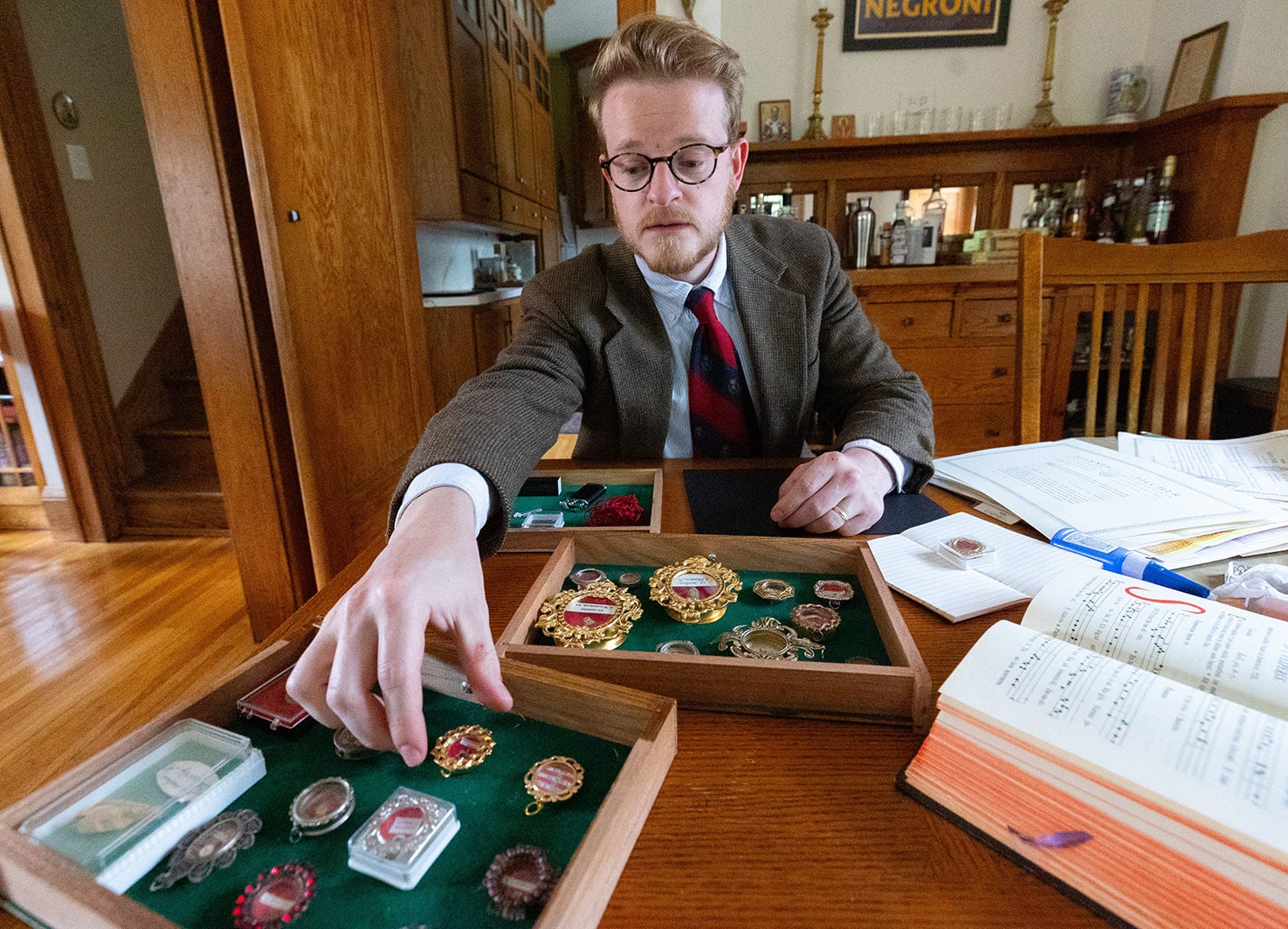MINNEAPOLIS (OSV News) — Recently, a visitor to a Wisconsin monastery entered a dimly lit chapel to pray. He noticed near the altar a mysterious, folded parchment in a brass reliquary with a faded wax seal.
The monks seemed unsure of the reliquary’s contents or origin. The visitor’s curiosity was piqued, and the abbot gave him permission to temporarily remove and investigate the packet.
Back at his office, the visitor carefully opened the packet and discovered a minute relic. He spent hours researching this puzzling treasure and was able to decipher the wax seal as that of a patriarch of Venice. He also found the relic likely dated back to the Catholic Church’s earliest days.
In the end, he came to an astounding conclusion: The relic was a tiny fragment of the body of St. John of Damascus (676-749 A.D.), the last-named Father of the Church, who was known for his strong defense of relics. The visitor cleaned and sealed the relic, set it in a new gold reliquary, and documented its millennium’s worth of history. It now sits, more visible and adorned, in the Wisconsin monastery chapel.
The monastery visitor was Sean Pilcher, 28, a member of All Saints Parish in Minneapolis — an internationally known specialist in the identification, restoration and authentication of Catholic relics. Working out of his home in South Minneapolis, he responds to requests from parishes, religious orders and individuals from around the world to authenticate relics, return them to places of honor and ensure their reverential treatment.
Pilcher’s unique work with relics
Pilcher’s work is crucial and in high demand. Traditionally, the church required that every altar have a relic. Many relics have not been adequately preserved, in Pilcher’s view, and most eventually require repair. He estimated that last year alone, he worked on over 500 relics. While he occasionally offers informal advice on relics free of charge, he is compensated for most of his projects.
The veneration of relics reflects both human nature and core principles of the Catholic faith, Pilcher explained.
“At the core of the practice is a yearning for the good that has gone before us — especially for things that call to mind departed loved ones,” he observed, pointing to a cherished clock that belonged to his grandmother, which hangs in his living room. “It could be our child’s first shoes, a lock of hair, a piece of the Berlin Wall, a flag that flew over a pivotal battlefield. The things we hold onto tell us who we are.”
“The Church recognizes this deep longing and elevates it,” he continued, noting that St. Thomas Aquinas, who always wore a relic of St. Agnes around his neck, reminds us that the soul in heaven is incomplete until united with the body at the final judgment.
Veneration of relics
“A person present in heaven is still truly connected to his body on Earth,” said Pilcher, adding that “the work of the saints done in heaven, then, is also wrought here on earth.”
Pilcher believes the veneration of relics should never be mistaken for mere sentimentalism.
“Veneration is, at its center, a biblical practice. In the New Testament, the faithful brought cloth to touch St. Paul to take to the ailing, and St. Peter’s mere shadow cured the sick,” he told The Catholic Spirit, newspaper of the Archdiocese of St. Paul and Minneapolis. “Since the earliest days of persecution, Christians have risked their own safety to recover the bones of the martyrs.”
Pilcher’s work varies widely. One day, he might research an obscure inscription or pore over historical documents to authenticate a relic found in a church sacristy cabinet. Other days, he might restore a relic for a parish or use his extensive network to find a relic for a new altar.
Recently, he put a church searching for a suitable relic in contact with some Franciscans, who agreed to make available a piece of fabric from clothing worn by St. Maximilian Kolbe. He is currently restoring the relic and preparing it for placement in an appropriate reliquary.
Pilcher encounters relics of both relatively unknown saints and giants of the Church. He is currently providing a “second set of eyes” for the authentication of relics of St. Thomas Aquinas, at the request of a monk in Rome, as well as restoring relics of St. Lawrence at the request of the vicar general of Rome. He investigated and authenticated a piece of the true cross of our Lord, at the request of a priest at the Pontifical North American College in Rome.
Knowledge and skill
Father Austin Barnes, parochial vicar of St. Mary in Stillwater, Minnesota, recently asked Pilcher to identify and restore the church’s altar relics.
“I marvel at Sean’s combination of knowledge and skill with relics and his personal Catholic faithfulness,” commented Father Barnes. “He has a sense of the great piety that should accompany such work,” and added, “most Catholics think you have to go to Rome to find this type of expertise, but we have it right in our own backyard.”
There are only about five relics experts in the United States today, and only a few in Rome, which is awash in relics, according to Pilcher. The profession requires a finely tuned understanding of relic knowledge, Latin, paleography (deciphering ancient manuscripts), artifact restoration, church history and heraldry. There is no school for relic work, and most of its traditions and conventions are passed down orally.
Pilcher developed his expertise while attending St. Louis University, where he majored in Catholic studies and studied Latin, Greek, Italian, German and Russian. He gained “hands-on” experience there by assisting an elderly priest who was rapidly losing his eyesight.
Eventually, Pilcher began work on his own, and he still uses reference materials his mentor and other elderly priests at St. Louis University gave him. He also formed the apostolate “Sacra,” through which he and two other American experts collaborate on various relics projects.
Appropriate presentation and authenticity
The appropriate presentation of relics has varied greatly through the centuries.
“Standard practice now is to place a relic inside a small, round (usually metal) reliquary case called a ‘theca,’ affixing it with red threads and the wax seal of the authority who prepared it,” Pilcher explained. A label — normally in Latin and written in a “learned shorthand” — identifies it. (For example, “Ex Oss. S. Bernardi, E.D.” means “from the bones of St. Bernard, Doctor of the Church.”) The seal holds the relic in place and ensures it has not been altered or removed. Age and travel can break the threads or make the seal difficult to read.
“This kind of authentication is a large part of our work,” noted Pilcher. “Documentation becomes lost, relics are borrowed (and sometimes never returned), and anything with glue eventually needs repair.”
Unfortunately, the internet age has produced a flood of relic frauds and forgeries. The Church teaches that it’s wrong to sell a relic for profit, but today on bidding sites, like Ebay, “you often find a host of people driving up the price of what appears to be a valid relic, only to discover later it’s a chicken bone,” observed Pilcher.
Recently, he noted, an alleged relic of St. Pius of Pietrelcina (Padre Pio) — complete with paperwork and a seal — sold for thousands of dollars on Ebay, yet “it was undoubtedly a phony.” Meanwhile, he said, a dealer on another auction site sold an unassuming yet doubtless authentic relic of an obscure Roman martyr for just the price of shipping after learning from Pilcher that profit-making is forbidden.
For Pilcher, his work is about much more than the personal satisfaction of solving relic puzzles. He noted St. Jerome’s testimony: “We honor the relics of the martyrs, so that we may adore him whose martyrs they are. We honor the servants, so that the honor of the servants might redound to their Lord.”
Relics, Pilcher believes, root us firmly on the earth, while fixing our eyes on heaven.
Mark Johnson writes for The Catholic Spirit, newspaper of the Archdiocese of St. Paul and Minneapolis.







